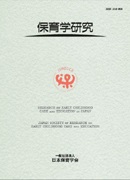Volume 53, Issue 3
Special Topics: Ways Children Help Each Other Develop in Everyday Life in ECEC Settings
Displaying 1-14 of 14 articles from this issue
- |<
- <
- 1
- >
- >|
Part I Special Topic Articles
General Remarks
-
2015 Volume 53 Issue 3 Pages 244-247
Published: December 25, 2015
Released on J-STAGE: August 04, 2017
Download PDF (477K)
Featured Articles
-
2015 Volume 53 Issue 3 Pages 248-260
Published: December 25, 2015
Released on J-STAGE: August 04, 2017
Download PDF (1278K) -
2015 Volume 53 Issue 3 Pages 261-272
Published: December 25, 2015
Released on J-STAGE: August 04, 2017
Download PDF (11302K) -
2015 Volume 53 Issue 3 Pages 273-283
Published: December 25, 2015
Released on J-STAGE: August 04, 2017
Download PDF (1208K) -
2015 Volume 53 Issue 3 Pages 284-295
Published: December 25, 2015
Released on J-STAGE: August 04, 2017
Download PDF (1239K) -
2015 Volume 53 Issue 3 Pages 296-305
Published: December 25, 2015
Released on J-STAGE: August 04, 2017
Download PDF (1103K)
Part II Special Reports from committees
Report on the 15th Symposium Organized by the International Relation Committee
-
2015 Volume 53 Issue 3 Pages 308-317
Published: December 25, 2015
Released on J-STAGE: August 04, 2017
Download PDF (6902K)
Part III Steps in Early Childhood Care and Education (No. 2)
-
2015 Volume 53 Issue 3 Pages 320-331
Published: December 25, 2015
Released on J-STAGE: August 04, 2017
Download PDF (1386K) -
2015 Volume 53 Issue 3 Pages 332-347
Published: December 25, 2015
Released on J-STAGE: August 04, 2017
Download PDF (1894K) -
2015 Volume 53 Issue 3 Pages 348-351
Published: December 25, 2015
Released on J-STAGE: August 04, 2017
Download PDF (491K) -
2015 Volume 53 Issue 3 Pages 352-353
Published: December 25, 2015
Released on J-STAGE: August 04, 2017
Download PDF (145K)
Contents
-
2015 Volume 53 Issue 3 Pages 354-355
Published: December 25, 2015
Released on J-STAGE: August 04, 2017
Download PDF (56K)
Afterword
-
2015 Volume 53 Issue 3 Pages 357-
Published: December 25, 2015
Released on J-STAGE: August 04, 2017
Download PDF (67K)
publication data
-
2015 Volume 53 Issue 3 Pages App7-
Published: December 25, 2015
Released on J-STAGE: August 04, 2017
Download PDF (50K)
- |<
- <
- 1
- >
- >|
